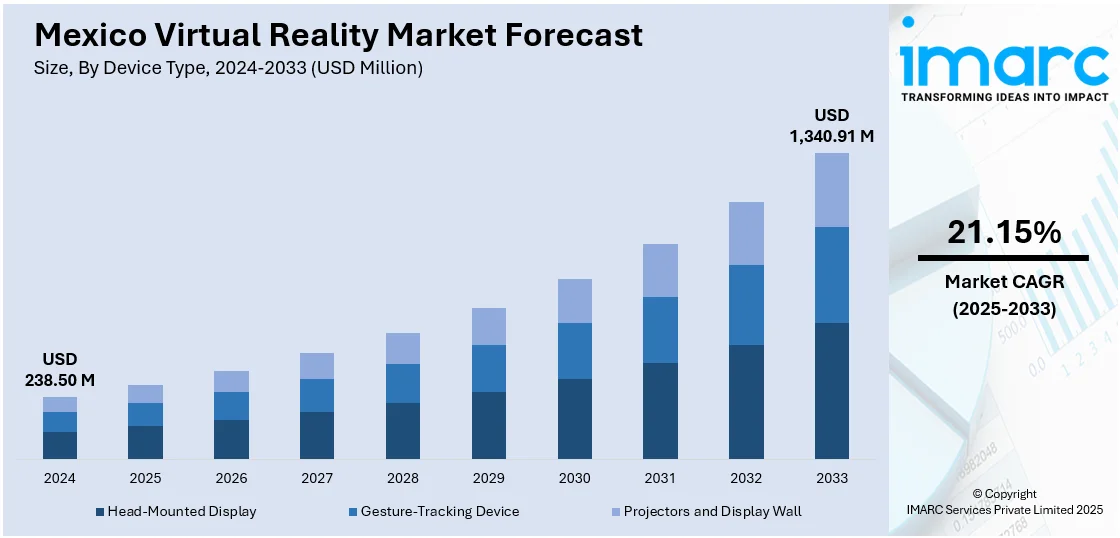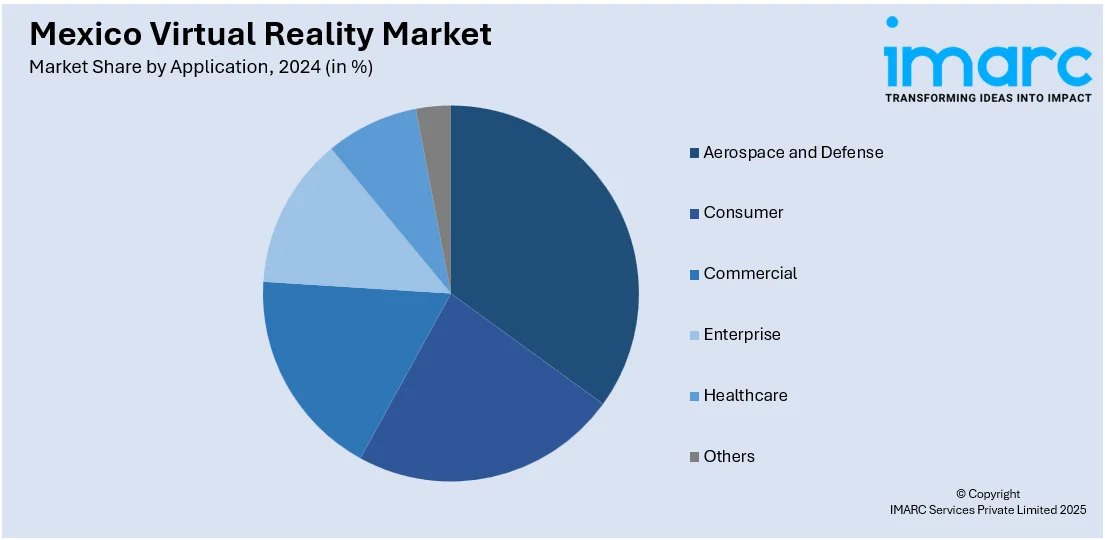
Mexico Virtual Reality Market Size, Share, Trends and Forecast by Device Type, Technology, Component, Application, and Region, 2025-2033
Mexico Virtual Reality Market Overview:
The Mexico virtual reality market size reached USD 238.50 Million in 2024. Looking forward, IMARC Group expects the market to reach USD 1,340.91 Million by 2033, exhibiting a growth rate (CAGR) of 21.15% during 2025-2033. The market is driven by advancements in VR hardware and software, expanding use in sectors like education and healthcare, along with rising consumer interest in immersive experiences, and improving digital infrastructure. These factors collectively enhance VR accessibility, usability, and demand, thus fueling the Mexico virtual reality market share.
|
Report Attribute
|
Key Statistics
|
|---|---|
|
Base Year
|
2024
|
|
Forecast Years
|
2025-2033
|
|
Historical Years
|
2019-2024
|
| Market Size in 2024 | USD 238.50 Million |
| Market Forecast in 2033 | USD 1,340.91 Million |
| Market Growth Rate 2025-2033 | 21.15% |
Mexico Virtual Reality Market Trends:
Technological Advancements in VR Hardware and Software
The Mexico VR market is significantly influenced by rapid improvements in VR technology. The immersive quality of virtual experiences increases while becoming more affordable through technical advances in headsets and tracking technology, and realistic graphic capabilities. Global technology giants are speeding up technology adoption in Latin America through their entry with localized products aimed at the regional market. Real-time interconnections in VR environments between multiple users are possible through the combination of cloud computing solutions alongside 5G connectivity support. These innovations improve usability, reduce hardware costs, and enable a broader range of applications, from entertainment and gaming to business training and design simulation. As the technology becomes more user-friendly and cost-effective, adoption is growing among businesses, educators, developers, and consumers, strengthening Mexico's position in the regional VR landscape.

Expanding Applications Across Industries
Virtual reality is no longer confined to gaming and entertainment. In Mexico, it is gaining traction in multiple sectors including education, healthcare, architecture, retail, and manufacturing. Educational institutions use VR for immersive learning and virtual labs, improving student engagement. In healthcare, it supports medical training and therapeutic applications such as phobia treatment and rehabilitation. Retailers use VR to simulate in-store experiences, while architects and designers visualize building projects before construction. Businesses increasingly rely on VR for employee training and remote collaboration, reducing costs and improving outcomes. The versatility of VR makes it a valuable tool across diverse industries, encouraging investments and partnerships that expand the market's reach and create opportunities for innovation.
Rising Consumer Demand for Immersive Experiences
Consumer interest in immersive digital experiences is a key factor driving the Mexico virtual reality market growth. Young, tech-savvy populations are seeking new forms of interactive entertainment, such as virtual concerts, VR gaming, and 360-degree videos. Social VR platforms are also gaining popularity, allowing users to interact in virtual spaces. With more local and Spanish-language content becoming available, accessibility for Mexican users is improving. Moreover, VR’s appeal in e-commerce—enabling virtual try-ons and store walkthroughs—is creating exciting new consumer touchpoints. This growing enthusiasm for immersive, interactive experiences is pushing device sales, app downloads, and VR content creation, making consumers one of the most influential forces behind the sector's expansion.
Mexico Virtual Reality Market Segmentation:
IMARC Group provides an analysis of the key trends in each segment of the market, along with forecasts at the country and regional levels for 2025-2033. Our report has categorized the market based on device type, technology, component, and application.
Device Type Insights:
- Head-Mounted Display
- Gesture-Tracking Device
- Projectors and Display Wall
The report has provided a detailed breakup and analysis of the market based on the device type. This includes head-mounted display, gesture-tracking device, and projectors and display wall.
Technology Insights:
- Semi and Fully Immersive
- Non-Immersive
A detailed breakup and analysis of the market based on the technology have also been provided in the report. This includes semi and fully immersive and non-immersive.
Component Insights:
- Hardware
- Software
A detailed breakup and analysis of the market based on the component have also been provided in the report. This includes hardware and software.
Application Insights:

- Aerospace and Defense
- Consumer
- Commercial
- Enterprise
- Healthcare
- Others
A detailed breakup and analysis of the market based on the application have also been provided in the report. This includes aerospace and defense, consumer, commercial, enterprise, healthcare, and others.
Regional Insights:
- Northern Mexico
- Central Mexico
- Southern Mexico
- Others
The report has also provided a comprehensive analysis of all the major regional markets, which include Northern Mexico, Central Mexico, Southern Mexico, and others.
Competitive Landscape:
The market research report has also provided a comprehensive analysis of the competitive landscape. Competitive analysis such as market structure, key player positioning, top winning strategies, competitive dashboard, and company evaluation quadrant has been covered in the report. Also, detailed profiles of all major companies have been provided.
Mexico Virtual Reality Market News:
- In February 2023, the first virtual reality training facility in Latin America opened in Mexico City, where police officers may rehearse maneuvers and sharpen their reflexes. In a 9-million-person city where local authorities say crime declined for three years, the center opened on February 15.
Mexico Virtual Reality Market Report Coverage:
| Report Features | Details |
|---|---|
| Base Year of the Analysis | 2024 |
| Historical Period | 2019-2024 |
| Forecast Period | 2025-2033 |
| Units | Million USD |
| Scope of the Report |
Exploration of Historical Trends and Market Outlook, Industry Catalysts and Challenges, Segment-Wise Historical and Future Market Assessment:
|
| Device Types Covered | Head-Mounted Display, Gesture-Tracking Device, Projectors and Display Wall |
| Technologies Covered | Semi and Fully Immersive, Non-Immersive |
| Components Covered | Hardware, Software |
| Applications Covered | Aerospace and Defense, Consumer, Commercial, Enterprise, Healthcare, Others |
| Regions Covered | Northern Mexico, Central Mexico, Southern Mexico, Others |
| Customization Scope | 10% Free Customization |
| Post-Sale Analyst Support | 10-12 Weeks |
| Delivery Format | PDF and Excel through Email (We can also provide the editable version of the report in PPT/Word format on special request) |
Key Questions Answered in This Report:
- How has the Mexico virtual reality market performed so far and how will it perform in the coming years?
- What is the breakup of the Mexico virtual reality market on the basis of device type?
- What is the breakup of the Mexico virtual reality market on the basis of technology?
- What is the breakup of the Mexico virtual reality market on the basis of component?
- What is the breakup of the Mexico virtual reality market on the basis of application?
- What is the breakup of the Mexico virtual reality market on the basis of region?
- What are the various stages in the value chain of the Mexico virtual reality market?
- What are the key driving factors and challenges in the Mexico virtual reality?
- What is the structure of the Mexico virtual reality market and who are the key players?
- What is the degree of competition in the Mexico virtual reality market?
Key Benefits for Stakeholders:
- IMARC’s industry report offers a comprehensive quantitative analysis of various market segments, historical and current market trends, market forecasts, and dynamics of the Mexico virtual reality market from 2019-2033.
- The research report provides the latest information on the market drivers, challenges, and opportunities in the Mexico virtual reality market.
- Porter's five forces analysis assist stakeholders in assessing the impact of new entrants, competitive rivalry, supplier power, buyer power, and the threat of substitution. It helps stakeholders to analyze the level of competition within the Mexico virtual reality industry and its attractiveness.
- Competitive landscape allows stakeholders to understand their competitive environment and provides an insight into the current positions of key players in the market.
Need more help?
- Speak to our experienced analysts for insights on the current market scenarios.
- Include additional segments and countries to customize the report as per your requirement.
- Gain an unparalleled competitive advantage in your domain by understanding how to utilize the report and positively impacting your operations and revenue.
- For further assistance, please connect with our analysts.
 Request Customization
Request Customization
 Speak to an Analyst
Speak to an Analyst
 Request Brochure
Request Brochure
 Inquire Before Buying
Inquire Before Buying




.webp)




.webp)












